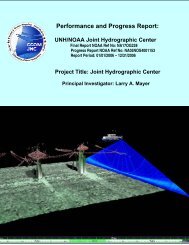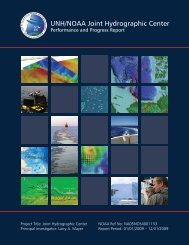Vessel Tracking Using the Automatic Identification System (AIS ...
Vessel Tracking Using the Automatic Identification System (AIS ...
Vessel Tracking Using the Automatic Identification System (AIS ...
Create successful ePaper yourself
Turn your PDF publications into a flip-book with our unique Google optimized e-Paper software.
Schwehr 2011: Presented at US Hydro, Tampa Fl 4<br />
<strong>System</strong> (PORTS), wea<strong>the</strong>r and sea surface data from<br />
NOAA nowCoast, and <strong>AIS</strong> ship tracking. The Portsmouth<br />
Response website was password-protected and provided<br />
basic services such as uploading and downloading data<br />
sets and saving polygons digitized on <strong>the</strong> web map by<br />
users.<br />
The Portsmouth Response application was presented<br />
to a diverse audience at <strong>the</strong> Portsmouth Harbor Response<br />
Initiative (CRRC, 2007), including commercial<br />
responders and local, state, and federal government response<br />
managers for <strong>the</strong> New England area. It was<br />
clear from participant reaction to <strong>the</strong> web application<br />
that <strong>the</strong>re was a need for an open web mapping system<br />
usable by all of <strong>the</strong> response team to supplement<br />
<strong>the</strong> GIS professionals armed with ArcGIS. However, <strong>the</strong><br />
Portsmouth, NH harbor is small and <strong>the</strong> system needed<br />
to be upgraded to handle larger areas with more concurrent<br />
users, and improved to add new features required<br />
by responders. At this point, <strong>the</strong> entire system was running<br />
on a Mac Mini sitting on an office desk at UNH.<br />
Requirements were ga<strong>the</strong>red from all <strong>the</strong> participants<br />
and <strong>the</strong> project was renamed to <strong>the</strong> Environmental Response<br />
Management Application (ERMA).<br />
During 2008 and 2009, <strong>the</strong> ERMA team worked to<br />
improve <strong>the</strong> infrastructure behind ERMA. As a part<br />
of this process, <strong>the</strong> team created a Caribbean instance<br />
of ERMA for Puerto Rico. To extend <strong>AIS</strong> coverage<br />
to o<strong>the</strong>r parts of <strong>the</strong> country, I connected ERMA to<br />
<strong>the</strong> USCG Nationwide-<strong>AIS</strong> (N<strong>AIS</strong>) data. <strong>AIS</strong> data was<br />
post-processed to aid in understanding several incidents<br />
in <strong>the</strong> waters around Puerto Rico.<br />
The ERMA software was moved into <strong>the</strong> controlled<br />
environment of <strong>the</strong> UNH Research Computing Center<br />
(RCC) and managed by <strong>the</strong> RCC team. During<br />
this time, noaadata, <strong>the</strong> <strong>AIS</strong> decoding software used in<br />
ERMA, had a difficult time keeping up with <strong>the</strong> volume<br />
of <strong>AIS</strong> traffic, even on a more powerful server. Noaadata<br />
was designed for research and was never optimized<br />
for speed. One small drill with ERMA was held in <strong>the</strong><br />
Portsmouth Harbor, but with only one <strong>AIS</strong> equipped<br />
response vessel, it was difficult to evaluate <strong>the</strong> use <strong>AIS</strong><br />
in ERMA.<br />
Spill of National Significance Drill 2010<br />
In March 2010, oil spill responders from around <strong>the</strong><br />
country met in Portland, Maine for a Spill of National<br />
Significance (SONS 2010) drill. This was an opportunity<br />
to observe USCG, NOAA, and o<strong>the</strong>r responders<br />
using ERMA and traditional response tools for a simulated<br />
oil spill off of Maine, New Hampshire and Mas-<br />
Figure 2. ERMA New England displaying simulated<br />
oiling area and response management zones during<br />
SONS 2010.<br />
sachusetts (Figure 2). I attended <strong>the</strong> drill as an observer<br />
and was surprised by <strong>the</strong> extent of <strong>the</strong> difficulties<br />
encountered by participants in <strong>the</strong> drill. NOAA and<br />
o<strong>the</strong>r groups involved in response drills typically have<br />
a review meeting a short time after <strong>the</strong> drill, called a<br />
”hot wash,” to ga<strong>the</strong>r lessons learned and directions for<br />
future improvements. The USCG refers to this as an<br />
After Action Report (AAR; Lloyd, 2010). In preparation<br />
for a hot wash after <strong>the</strong> drill, I submitted a list<br />
of observations about <strong>the</strong> command center operations<br />
based solely on one day. It is challenging to extrapolate<br />
one day of a drill to what might occur during an actual<br />
incident. However, <strong>the</strong>re are a number of key points<br />
that can be addressed.<br />
The most striking observation was how frequently<br />
location names caused difficulties. Local names were<br />
unfamiliar to staff from out of <strong>the</strong> area and problems<br />
were compounded by spelling errors and misheard<br />
names. Names used by those in <strong>the</strong> field were frequently<br />
not available in public mapping systems such as<br />
Google Maps, Map Quest, Open Street Map, USGS Geographic<br />
Name Information Service (GNIS), etc. This<br />
miss-communication created a confusing environment<br />
where staff in <strong>the</strong> command center were unsure where<br />
responders were located when reporting <strong>the</strong>ir observations<br />
by voice communication. To add to <strong>the</strong>se name<br />
issues, almost no numeric coordinates were transferred<br />
over phone and radio, which also have accuracy issues.<br />
Names work best when all parties involved are familiar<br />
with <strong>the</strong> names, and <strong>the</strong> names are not ambiguous (e.g.<br />
”rocky point”).




